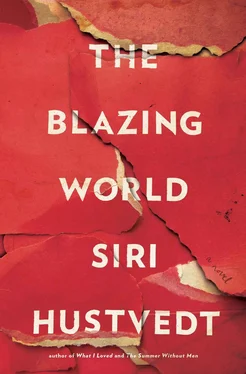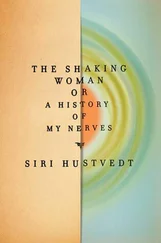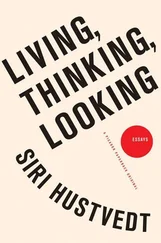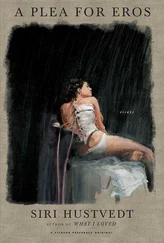Rosemary Lerner (written statement)

There is a pronounced tendency in all the arts to mythologize the dead, by which I mean the creation of reductive narratives to explain artists’ lives and works. I have been an art writer for more than forty years and have witnessed this time and time again. The reasons for simplification are often ideological, but sensational biographies can also erase all nuance when they appear to fit a prefigured character and script — tragic hero or heroine, victim, genius. It is helpful to undermine these wooden scenarios. Harriet Burden was not nearly as obscure or unnoticed as she has been made out to be in the stories that are now circulating about her career. Her work was represented in no less than five group shows in the seventies and I, for one, singled her out in a review I wrote for Art in New York in 1976:
Harriet Burden’s uncanny architectural piece with its slightly askew walls and floors, its emotionally charged figures, pastel palette, and dense use of text lingers in this reviewer’s mind as the work of a brilliant and strikingly independent artist.
Albeit a minority view, I was not alone. Archie Frame, Beatrice Brownhurst, and Peter Grosswetter all commented favorably on her two one-woman shows, both at major New York galleries. Yes, both dealers let her go, but this is hardly a unique fate. It merely places Harriet Burden among the numerous distinguished visual artists, male and female, who were respected by other artists, received mixed reviews, and didn’t attract big collectors to their work.
Reviewers of every ilk like to feel they are above a work of art. If it puzzles them or if they are intimidated, they are more than likely to trash it. Many artists are not intellectuals, but Burden was, and her work reflected her wide learning. Her references spanned many fields and were often impossible to track. There was also a literary, narrative quality to her art that many resisted. I am convinced that her knowledge alone acted as an irritant to some reviewers. I once had a conversation with a man who had excoriated her first one-woman show. When I brought up his review and offered a defense of her work, he was hostile. He was not a stupid man and had written well on some artists I admired. He had attacked Burden’s work as confused and naïve, the very opposite, in fact, of what it was. I realized that he had been incapable of a fair-minded appraisal because, although he prided himself on his sophistication, the multiple meanings of her carefully orchestrated texts had eluded him, and he had projected his own disorientation onto the work. His last words to me were “I hated it, okay? I just hated it. I don’t give a damn about what she was referring to.” That conversation has stayed with me, not as a story about Harriet Burden so much as a lesson for myself: Beware of the violent response and the sophisms you may use to explain it.
Then there is the question of sex. It has often taken women longer to gain a hold in the art world than men. The remarkable Alice Neel worked without much attention until she was in her seventies. Louise Bourgeois made a breakthrough with her show at MoMA in 1982. She was seventy. Like Burden, these women were not ignored but gained prominent recognition only late in their careers. During her lifetime the painter Joan Mitchell was known and admired, but it wasn’t until after her death that her place among second-generation abstract expressionists began to grow enormously. Grace Hartigan was the only woman in MoMA’s legendary New American Painting exhibition in 1958–1959. Eva Hesse, who was at Cooper Union only a few years before Burden, died in 1970 at age thirty-four of a brain tumor. She didn’t live to see her star continue to rise or the power of her influence on younger artists. But when she was alive she complained that her work did not receive the serious attention given to the work of her male colleagues, and she was right. There were many reviewers who reviewed her life, not her art. Lee Krasner’s work was subsumed by her husband’s in the eyes of the art world. Jackson Pollock was and is deified as a Romantic hero. A year before Krasner died, a retrospective of her work was mounted, but by then, she said, it was “too late.” Mostly, the art business has been about men. And when it has been about women, it has often been about correcting past oversights. It is interesting that not all, but many women were celebrated only when their days as desirable sexual objects had passed.
Although the number of women artists has exploded, it is no secret that New York galleries show women far less often than men. The figures hover around twenty percent of all one-person shows in the city, despite the fact that almost half of those same galleries are run by women. The museums that exhibit contemporary art are no better, nor are the magazines that write about it. Every woman artist faces the insidious propagation of a male status quo. With almost no exceptions, art by men is far more expensive than art by women. Dollars tell the story. After giving up on a public life as an artist, Burden decided to experiment with the perception of her work through the use of masculine personas. The results were striking. When presented as the work of a man, her art suddenly found an enthusiastic audience. Caution is in order, however. Art world trends are constantly changing. The raw is in one day, the cooked the next. And there is an ever-present hunger for youth, the latest ingénue or mangenue on the menu. Might a young woman have served Burden equally well? Probably not, but the story cannot simply be told as a feminist parable, even though it seems obvious that sexual bias played a determining role in the perception of Burden’s work. And yet, each of her masks seemed to uncover a different aspect of her imagination, and it is not unfair to say that the trajectory of her artistic experimentation became a movement toward an increasing and almost sinister ambiguity.
Anton Tish, who has disappeared from the art world entirely, seems to have been little more than a puppet. Phineas Eldridge, on the other hand, brought his own searing charm to The Suffocation Rooms they worked on together. He, too, has retired from art but not from speaking out, and his letter to Art Lights remains, to my mind, not only a tribute to Burden, the woman, but a perspicacious reading of her work.
Burden’s involvement with Rune is, at least to me, both sad and mysterious. The controversy over his apparent suicide and the antics of Oswald Case, whose book Martyred for Art turns Rune into the genius-celebrity of a new technological era, have only blurred the real issues. It is true that four of the window pieces cannot be absolutely attributed to Burden, and there are those who insist they belong to Rune. The final verdict has not been made, and the uncertainty may continue for quite some time, if not forever. Nevertheless, a black-and-white treatment of the Burden-Rune story is uncalled for. It leads to mythmaking at its worst: The wish supplants the evidence. It ignores Burden’s autobiographical writings, which make a strong case for out-and-out theft of some of her pieces by someone, possibly Rune. In a notebook entry from September 12, 2003, she wrote, “Four works have vanished from the studio overnight. I am desperate.” Why would she write this if it weren’t true? Case’s theory is that Burden framed Rune by leaving written records that strongly hint at his malfeasance and that she did it out of envy and spite. Case relies heavily on what Rune told him, and he had access to almost none of Burden’s papers when he wrote his book. He quotes a single sentence taken from three pages of her writing that were published in the spring issue of Dexterity (2008), the year of her retrospective at Grace. “It is so easy for Rune to shine. Where does that effortlessness come from? How do people acquire it? He is so light. I am earthbound, a Caliban to his Ariel.” This is hardly proof of some Machiavellian plan to poach another artist’s career.
Читать дальше













